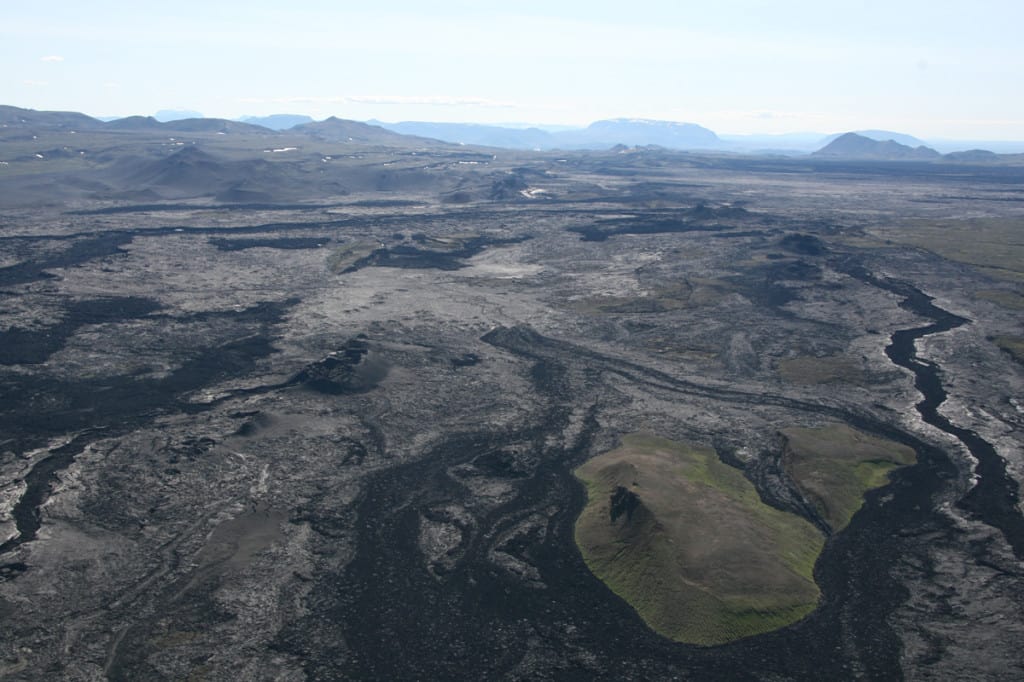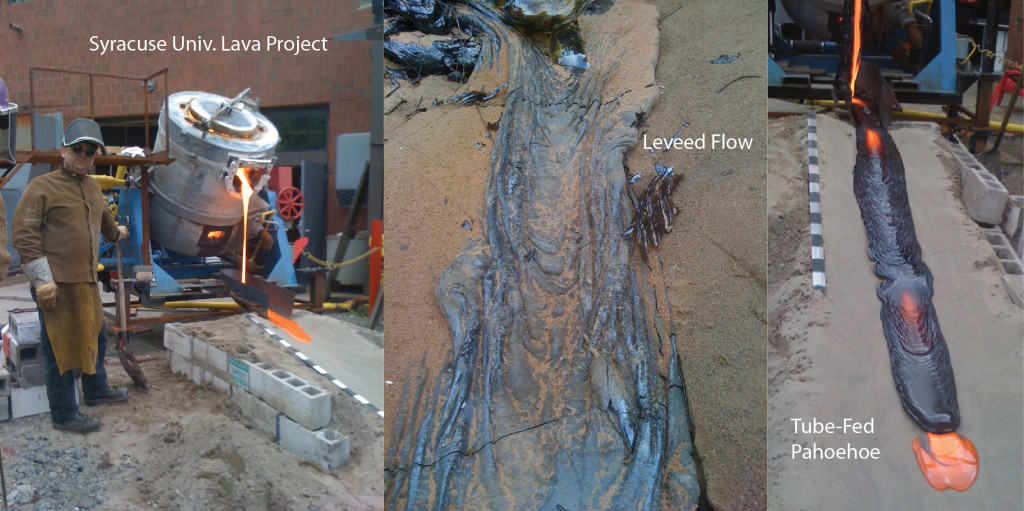Participants will investigate the behavior and morphology of basaltic lava flows from two very different but related perspectives: field observations of historic basaltic lava flows in Iceland and large-scale lava flow experiments conducted at Syracuse University. Experiments will be designed to constrain the factors that control various features found in the natural lavas.
What: The project will tour key volcanic centers in Iceland before focusing for about 10 days in the 1974-1984 basaltic lava flows of Krafla in northern Iceland. Detailed mapping and observations of the lavas will be used to design specific lava flow experiments conducted under the SU Lava Project (http://lava-dev.syr.edu). The experiments will use re-melted ancient basalt to make lava flows up to a few meters across under varying conditions of temperature, effusion rate, slope, and substrate. Data collected during the experiments and from dissected flows will be available for continuing studies. These experiments represent uncharted territory in the study of basaltic lava flows.
When: June 15-July 13, 2014
Where: 2 weeks in northern Iceland and 2 weeks at Syracuse University
Who: Jeff Karson (Syracuse University), Rick Hazlett & Bob Varga (both at Pomona College) and 6 students
Project Overview and Goals:
Basaltic lava flows constitute the most common and voluminous volcanic outpourings on Earth and the terrestrial planets. Besides highly visible historic eruptions in Hawai’i, Iceland, Italy and Siberia, ancient basaltic lavas also dominate vast areas of the continents and almost the entire deep seafloor. Despite the significance of basaltic lava flows, many questions remain regarding the behavior of lava flowing across the surface and the interpretation of features found in ancient lavas.
Active lava flows take place in remote locations and under conditions that are essentially uncontrolled. At best, key aspects of flows can be reconstructed so some extent. In large-scale experimental lava flows at Syracuse University, the individual (and combined) effects of the primary factors that influence lava flows can be investigated in a safe, controlled environment. Data recorded during the experiments can be compared to features of the cooled flows and to features in ancient lava flows. Documenting the effects of key parameters on lava flow processes is necessary for understanding the accretion of lava flow fields, assessing hazards, and understanding the significance of lava flow morphologies on Earth, the seafloor, and other planetary bodies.
Potential Student Projects
Students will be encouraged to participate in designing and planning their research projects with guidance from the instructors. Some possible projects are listed below. Note that all projects can be adapted to fit the interests of their faculty advisors and available analytical facilities. These may involve varying degrees of descriptive, analytical, and theoretical approaches that can be explored in depth back at the students’ home institutions. The instructors will help coordinate this work with the students’ faculty advisors.
1. Pahoehoe/A’a transition. These two lava morphologies are well known and fundamental to introductory geology classes. Despite their common occurrence, the factors that determine these forms remain a matter of discussion. Led by observations from Iceland, experiments at SU will attempt determine the conditions that produce them.
2. Lava/wet soil interactions. Lava near Húsavik flowed over wet, marshy ground producing hundreds of small (few meters across, 1-2 m high) lava blisters. Each of these is constructed of solid lava in a conical shape, commonly with a partially collapsed roof. Lava experiments at SU with lava flowing over wet sand commonly also produce small lava blisters. Comparing field and experimental results can shed light on this process.
3. Folding of lava flow surfaces. Observations in the field and on experimental lavas show evidence of the complex folding that affects pahoehoe flow surfaces. Measurements of fold dimensions in the field in Iceland and on fully documented flows at SU can be used to evaluate lava crust rheology and previous approaches based on classical folding theory.
4. Tube-fed Pahoehoe Formation. This type of flow, with a solid crust and flowing interior (commonly hollow after drain-out) is very common in basaltic terranes including Iceland. Similar features form in the SU experimental lava flows under some conditions. Combined field and experimental data will help define the conditions under which tube-fed flows form.
5. Flow Over Steps. Lava commonly flows over steep topographic steps and cliffs. The center part of the flow appears to behave differently from the cooler, slower-moving, leveed edges of the flow as they cascaded over the steps. This situation is easily reproduced on a small scale in the SU experiments. Changes in morphology and lava behavior can be documented in the field in Iceland and with controlled experiments.
6. Magmatic Flow Directions. Magmatic flow directions in lava flows and dikes can be determined using a number of techniques including measurements of strain from the alignment of crystals or vesicles and other small-scale structures. Anisotropy of magnetic susceptibility (AMS) is another widely used approach. As far as we know, no studies have attempted to link these measurements of strain and flow direction in situation where there are independent constraints on strain or flow direction. Comparing results from Icelandic lava flows and experimental flows could shed new light on patterns of strain in lava flows.
Working Conditions
Iceland is a spectacular setting for the field portion of this project. Travel from JFK is only about 6 hours. No visas or work permits are required. It is a very tourist-friendly environment where nearly everyone speaks English. Reykjavik is a very European city but most of this project will be conducted in much more sparsely populated areas in the north. There will be a few day-long car trips. Accommodations will be at small guesthouses and a permanent house owned by the University of Iceland near Krafla. No camping will be required.
Students should be prepared to work all day outdoors under moderately cool (typically ~50°F) and possibly rainy conditions. Students should be expected to be able to hike for several kilometers over mostly gentler topography but very rough and uneven volcanic landscapes. We will be near small towns but students need to bring all necessary field gear. There are no dangerous plants, animals or insects.
Syracuse University is located in Syracuse, NY in the Finger Lakes Region of central NY. University housing and meals will be available at walking distance to the Comstock Art Building where the lava flow experiments will be conducted. Travel can be arranged through Hancock International Airport, Amtrak, or bus service.
Safety
Iceland: While all field investigations have their inherent risks, fieldwork in Iceland is particularly forgiving. Should they be necessary, excellent emergency services are available, in most cases within 2 hours of all of the target areas. Colleagues at the University of Iceland will be available if any assistance is required. Cell phone communication is available in all areas of study.
Syracuse University: Despite working with molten lava, experiments in the SU Lava Project are extremely safe. With the experience from >100 lava flows in many different conditions, there is no danger of violent activity, even for flows poured directly into water. Working around our lava flows is no more dangerous than being around a wood-burning stove or fireplace. The lava will be poured by Professor Robert Wysocki and his trained students. Students directly engaged in experiments will use appropriate protective gear (goggles, gloves, leather overalls, etc.).
Required Gear
Large duffle bag for travel
Sleeping bag and pad (for Iceland)
Day pack
Rain jacket and pants
Warm gear in layers
Sturdy boots
Sun glasses, sunscreen, hat, gloves
Geology field gear as needed (hammer, notebook, hand lens, camera, gps, compass)
Personal first aid kit
Water bottle
Recommended Courses/Prerequisites
Students will get the most out of the program if they have completed courses in mineralogy, petrology or volcanology, and structural geology. Field geology experience would be a plus.
Costs: Travel, housing and field costs will be covered by the project. Students are expected to contribute toward meal expenses.
Contact Information
Jeff Karson (jakarson@syr.edu); tel.: 315-443-7976


